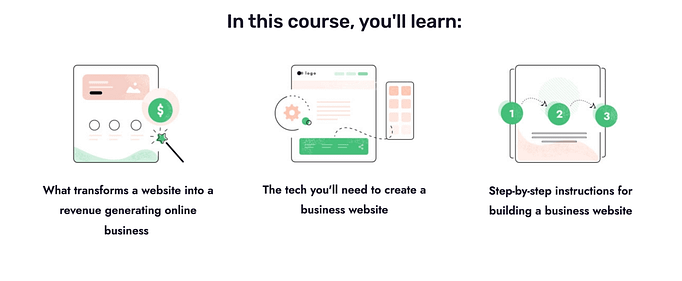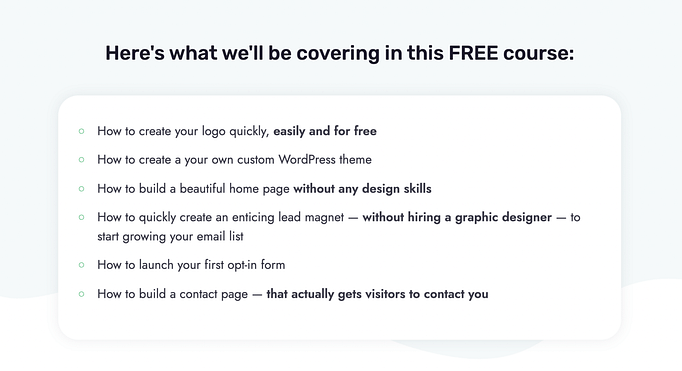Let’s set the scene.
You feel like you’re doing everything right to make a knock-out online course. But, it’s met with the digital tumbleweed moment that every online creator dreads. You just can’t rake in the revenue that you feel that your content warrants.
You need to get the upper hand on course creation.
And to do that, you need to know how to create a curriculum.
By doing so, you’ll cash in on the engagement that your content deserves.
Are you ready to seriously transform your online course and teaching strategy into an engaging experience for both you and your students?
In this article, I’ll tap into the structure that a curriculum creates, cover what exactly a curriculum is, and how you can use it to your advantage.
Let’s dive in…
More...
What Is a Curriculum and Why Is It Important to Make One?
In short, a curriculum offers structure and purpose for your students’ learning experience. It ties together the objectives of how, when and what your students learn.
This includes:
- Your course content, materials and resources
- The magic that connects your learning outcomes to key skills
- Captivating language that sells your magnetic personality
A curriculum is a blueprint that outlines how you deliver your knowledge to your students. With this blueprint, you can customize the learning experience in your own way without losing sight of the main task at hand: delivering the outcomes of your course.
To go into this a little more, let me ask you a question.
Do you think that course creation and marketing are completely separate?
Your immediate response was probably yes. Try again.
They’re two sides of the same coin. And course curricula are the main link between the two.
A good curriculum brings consistent engagement into your course, which raises the bar on the perceived value of your content with your students. To achieve this, you need to create a course for your students, rather than for your own gratification.
Our CEO, Shane, calls this the Ivory Tower Problem. Where you’re the onlooker that watches over, thereby separating yourself from your product and audience, rather than getting your hands dirty and being actively involved.
This all sounds pretty important to me. Let’s dig a little deeper…
Types of Curriculum
Curricula really encourage you to think outside of the box when creating a course. The curriculum types we’re about to look into cover all aspects of your students' learning to create a well-rounded experience that an online course needs to be worth a $200+ price tag.
Before we get into this, I suggest making yourself some tea, getting comfy, and taking out a notepad and a pen.
Let’s go…
1. Assessed Curriculum
How will you measure your student’s success?
An assessed curriculum is put together to test your students.
As a course creator, this is essential for you. It provides instant feedback on how your students learn through your content, and what areas might need improvement.
For students, regular assessment is the gratification and motivation they need to continue on with your course.
An assessed curriculum, also known as a tested curriculum, ranges from quizzes and projects to multiple choice questions and concept checking games. The more variety you include in your assessed curriculum, the more you understand how your students learn and respond to these testing methods.
2. Recommended Curriculum
When you don’t know how to make a curriculum yourself, a recommended curriculum is a go-to for guidance. It comes from the education experts in your chosen field.
A recommended curriculum is a predefined bank of policies, including all the skills that students should learn in a chosen subject. It’s very data driven with very little on what students are interested in. So, it’s best to use this type of curriculum as a starting point only.
The expertise laboriously poured into this type of curriculum comes from a range of very official sources, including policy makers, legislators and accredited researchers in your chosen field.
You can take whatever you want from it to create a curriculum that meets your students’ needs.
3. Supported Curriculum
To generate interest in your course, you need resources to stimulate your students' curiosity in your subject. For this, you need a supported curriculum.
You’ll need to put on your most creative hat to pull it all together. A supported curriculum draws on resources from just about anywhere to boost the learning experience (hence why it’s called a supported curriculum).
This can involve ebooks, companies that specialize in your subject, industry experts, mobile applications, artists, or thought leaders.
You get the point. It’s literally anything that isn’t your course content, but related to your course topic.
4. Hidden Curriculum
You’re not supposed to do anything with a hidden curriculum. Just be aware of it…
A hidden curriculum is the unwritten rules of your chosen field of expertise, and teaching style. It asks you to think about what you do automatically and don’t intend to include in your course content.
It’s like Fight Club — you don’t talk about it, but you do it and you’re expected to. To make this more tangible, a hidden curriculum in an online course environment is measured by societal expectations, unique perspectives and business culture.
But only being aware of it is a huge missed opportunity.
Perspective, society and business culture are all a part of your personal branding. This is essentially how you’re teaching and your business is received by your students. And it shines through in the language and tone of your content, and how you reach out to your students.
5. Excluded Curriculum
We’re still in Fight Club.
An excluded curriculum very much does what it says on the tin… in an abstract way. It’s what’s deliberately not included in your course.
Educators have some genius sales techniques up their sleeves, and this is one of them. An excluded curriculum is not only a tactic for narrowing down your audience but also helps you zone in on what’s important.
This is a golden ticket for boosting the perceived value of your course.
An excluded curriculum allows you to unapologetically state what your course is, by clearly defining what it is NOT. It gives you space to become super niche in your field of expertise and cut out any of the fluff that would be there otherwise.
PLUS, what you don’t include, you can always create another course with.
6. Learned Curriculum
Okay, we’re back on comfortable ground.
What will your students get out of your course? This is a learned curriculum.
It covers what your students will learn in your course and be able to do by the end of it. This is the most common type of curriculum, and forms the backbone for your online course. Most importantly, this is what your content will be focused around.
Important note: While these are the defined types, to create a curriculum that works well, it’s best to mix and match.
Curriculum types layer on top of each other to make a well-rounded learning experience that best suits your students needs and wants.
With this in mind, it’s time we move on…

Nurture your ideas and research to create a curriculum that engages your students in your course.
How to Create a Curriculum For A Course
When thinking about how to make a curriculum, you have to combine your course intent with your teaching style and what your students ultimately want to learn.By combining selected curriculum types you’ll get the perfect balance. And to do this, we’re going to work backwards.
Before we begin, one of the best writing and planning tools out there is the Gingko Writer app (formerly Gingko app). It allows you to move all your ideas around and get super clear on your thinking process by visualizing the whole experience.
Okay, now we can start!
Identify Your Intent
Your intentions, and your students’ reasons for taking the course will determine every factor involved in creating a curriculum.
Consider why you are teaching your course. What questions do your students want answered? And most importantly, what’s going on in your students’ minds when they initially look for your course?
I’ll say it again, course creation and marketing are two sides of the same coin.
You need to roll up your sleeves and do some customer development work to see WHY your students need and want this course to find your intent and make sure that you’re all on the same page.
Online learners are active and eager to learn. So ask them what they need and they will answer.
And if you don’t have students just yet, browse forums and dig into the comments sections to see what students are talking about, what questions they are asking, what they wish they had. And most importantly, where they are currently going for answers. Then, you can work out how you can deliver something more.
It’s essential that you spend time nailing this to prevent that digital tumbleweed moment.
As our CEO Shane says: “Ask people what they want, and then build it for them… but better.”
Outline Your Course
Curricula are like jigsaw puzzles, you know how they’re supposed to look and you have the pieces — you just need to put them together.
Similar to jigsaw puzzles, it’s not always as easy as it first seems.
To make creating a curriculum easier, outline your course to visualize it from the top-down. Don’t get into the nitty gritty of what or how you’re teaching just yet. We want to generalize as much as possible.
How can your course guide your students to the intention that you have just set, intuitively?
What are the obvious things that you would need?
Let’s look at an example. One of the free courses at Thrive University is How to Build an Online Business Website in a Weekend (you just need to create a login to access it).
Before I show you what the outline is, think about the ingredients you’d need to set up a business website.
…Some kind of tech stack?
…A way to make money?
…The right guide to learn how to do it?
Bingo!

The three core elements of 'How to Build a Business in a Weekend'.
Three is the magic number when it comes to getting started building your course outline.
It highlights the beginning, middle and end stages of your course. From there, you can flesh out more ideas for your course outline to make a curriculum that guides your students to their desired outcome.
But remember, you’re looking at this from the top-down! So keep it simple.
Define What Will Be in Your Course
Now that we’ve nailed down the structure, it’s time to get into the fine details of your course.
What methods and concepts will you introduce to get your students to achieve what’s stated in your outline? This is your starting point. From there, develop a framework of topics and ideas that are interesting, clear, and concise.
I want to introduce the Tour Guide Method here. It’s a great concept that Shane goes into in our premium course, Course Craft.
At no point, should you feel that ALL of your knowledge has been laid on the table.
Your course flow should interest your students by being directly relevant to them, while only exposing a snippet of what you actually know. Most importantly, you should make it obvious that you do know more. This is a hook to motivate your students to not only finish your course, but come back for more.
Create an Assessment Plan
At this stage, you’ll be eager to start creating content for your epic course.
But before that, I cannot emphasize enough how important it is to work out how you are going to measure your students’ success.
An assessment plan is a reward tool. It’s a system that you set in place to check that your students have learned what you intended, and to make them feel good about themselves for doing so.
Assessments can include:
- Checksheets
- Quizzes
- Interactive bonus videos
- Useful homework tasks
- Small projects
The point of an assessment is to get your students to do things that prove to themselves they learned something.
To look further into how to write a curriculum for a course, Build Online Courses Your Customers Will LOVE with Thrive Apprentice.

Engaging your students online offers a chance to establish a deeper understanding of your audience.
Engaging Your Students
An online course is THE tool to measure and understand your students’ experience of your business. There is literally no other product out there that offers such a deep connection.
This comes from the engagement that you generate when you create a curriculum.
So, how do you do it?
Set Goals and a Timeline
Active engagement comes from clearly defined timelines. This is not just how long your course will be, but what your students will achieve in this time. You want to really set this in stone.
Your timeline will correlate with your course outline, so that your students know exactly what they are doing and when. But, to make a curriculum that is engaging, it must fit in with your students’ lifestyles too.
Are they full time moms? Make sure your videos are short and easy to revisit.
Is it for full-time workers looking to start a side hustle? Make it actionable over a weekend.
You get where I’m going with this…
Two sides of the same coin.
Get Clear on Desired Outcomes
Completing tasks successfully is so satisfying. Use this to your advantage.
The key is to have the tasks you set for your students align with the desired outcomes they want from completing your course. This is very similar to what we established with intent, but now we can get super specific. Outcomes are exactly what your students will achieve when completing your lessons.
To deliver on desired outcomes, you need to specify what they are at the start, and then tell your students how they were achieved at the end.
Let’s look at How to Start an Online Business again as an example…
In the video ‘Connecting Your Email Provider and Opt-in Form’, Christine, your teacher, walks you through how to connect your email and opt-in form using Thrive Architect.
You pause the video, you complete part of the task, then play again. Rinse and repeat, and you’re done in about 15 minutes.
Not only have you completed the learning outcome for the lesson (which is clearly stated in the title), you’ve also set up your first email automation for your business website. Sweet.
Outstanding Teaching Materials and Resources
To finish off on engagement, we’re going to touch back on the perceived value of your course.
Good quality teaching materials and resources are a chance to show off your knowledge and the extent of it without putting all your cards on the table. It’s like saying “There’s more where that came from” but you’re backing up your statements with authoritative resources that are super useful.
To do this, you can make the most of the content that you do want to share by mixing it up on the delivery.
I’m talking about curating downloadable PDFs, checklists, and unapologetically — not always affiliated — links to thought leaders in your field. These can also be presented as bonus materials for students to further their learning.
But, don’t just link to any old thing that you find at the top of your Google search results. Link to resources and materials that you’ve personally found helpful.
Become part of your students’ learning process by sharing part of yours.
This taps into the final and most important teaching material that you have, and something that is crucial to make a curriculum that works, your personality.
By showing off a little of who you are with personal touches in the content you create, you’ll hook your students in to learn more with you.
For more on adding a little personal touch to your course, check out 8 Hacks to Become Better at Teaching Online Courses!
Best Example of a Curriculum
Your curriculum will grow with your online business as a fundamental marketing tool to ensure that you continue to deliver what your students want and benefit from. It’s an abstract concept that’s incredibly tangible when you think about it in the right way.
To show you how this works in the real world (and not Fight Club), I’m going to bring back the example of How to Create a Business Website in a Weekend. Because I really think the course is that good… and because I just completed it myself.
To look at this objectively, I’m going to lay out how I was engaged and motivated to complete the course so we can really see how to create a curriculum that works.
Let’s start by looking at the sales page for the course so you get an idea of what it contains:

The 'How to Build an Online Business in a Weekend' gets the ball rolling by walking you through the tasks that you’ve been avoiding to get your business up and running.
The intent of this course is to motivate those who have business ideas, but are stuck on taking action to build and launch their business website.
To help overcome that hurdle, Christine uses a combination of Thrive Theme Builder and external resources, like MailChimp and Canva to hold your hand through the whole process.
The assessment plan is integrated into the whole course, and is checked off as you design a logo, create an opt-in form, build a contact page and set up an email address. Christine walks you through one stage at a time in the lessons. You learn as you go. And at the end of the course, you have a pro-looking website working to get your first customers!
This shows you just how creative you can get when making your curriculum. Here, you have an assessed, learned and supported curricula all going on at the same time.
Pretty cool now you see it, hey?
But that’s not all.
Christine has been really careful to not give away all of her cards here.
The course leaves you with hints as to what the next steps could be, such as email marketing, lead generation, and all that content that comes with them. So it leaves you super motivated to take another course with Christine to build on these marketing ideas.
After a student completes Christine’s course, does she have:
- Engagement?
- Hidden and excluded elements used to an advantage?
- Students left wanting to learn more?
Check. Check. Check.
Put Your Curriculum into Action…
Alright, so you’ve got a killer curriculum for your course with riveting content and resources.
But your students aren’t going to find this content by themselves. So, it’s your turn to make and ship your website…
Sign up to get your free step-by step walk through on How to Create and Sell Online Courses and you could be selling your course by tomorrow!






